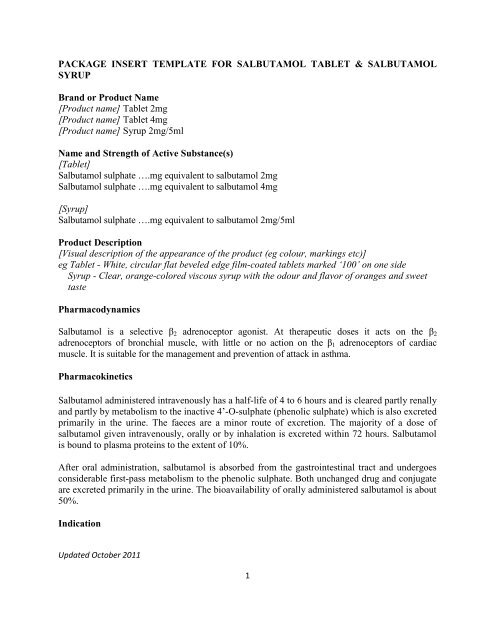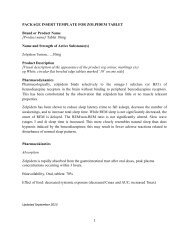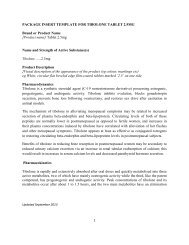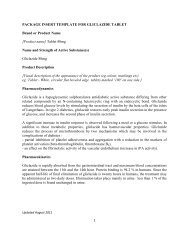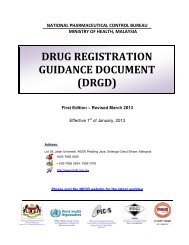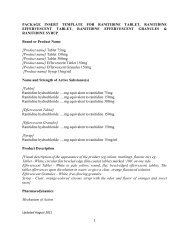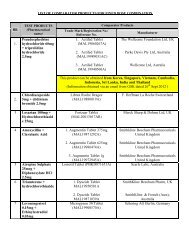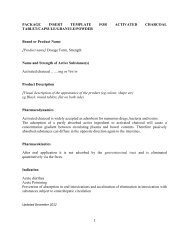PACKAGE INSERT TEMPLATE FOR SALBUTAMOL ... - BPFK
PACKAGE INSERT TEMPLATE FOR SALBUTAMOL ... - BPFK
PACKAGE INSERT TEMPLATE FOR SALBUTAMOL ... - BPFK
Create successful ePaper yourself
Turn your PDF publications into a flip-book with our unique Google optimized e-Paper software.
<strong>PACKAGE</strong> <strong>INSERT</strong> <strong>TEMPLATE</strong> <strong>FOR</strong> <strong>SALBUTAMOL</strong> TABLET & <strong>SALBUTAMOL</strong>SYRUPBrand or Product Name[Product name] Tablet 2mg[Product name] Tablet 4mg[Product name] Syrup 2mg/5mlName and Strength of Active Substance(s)[Tablet]Salbutamol sulphate ….mg equivalent to salbutamol 2mgSalbutamol sulphate ….mg equivalent to salbutamol 4mg[Syrup]Salbutamol sulphate ….mg equivalent to salbutamol 2mg/5mlProduct Description[Visual description of the appearance of the product (eg colour, markings etc)]eg Tablet - White, circular flat beveled edge film-coated tablets marked ‘100’ on one sideSyrup - Clear, orange-colored viscous syrup with the odour and flavor of oranges and sweettastePharmacodynamicsSalbutamol is a selective β 2 adrenoceptor agonist. At therapeutic doses it acts on the β 2adrenoceptors of bronchial muscle, with little or no action on the β 1 adrenoceptors of cardiacmuscle. It is suitable for the management and prevention of attack in asthma.PharmacokineticsSalbutamol administered intravenously has a half-life of 4 to 6 hours and is cleared partly renallyand partly by metabolism to the inactive 4’-O-sulphate (phenolic sulphate) which is also excretedprimarily in the urine. The faeces are a minor route of excretion. The majority of a dose ofsalbutamol given intravenously, orally or by inhalation is excreted within 72 hours. Salbutamolis bound to plasma proteins to the extent of 10%.After oral administration, salbutamol is absorbed from the gastrointestinal tract and undergoesconsiderable first-pass metabolism to the phenolic sulphate. Both unchanged drug and conjugateare excreted primarily in the urine. The bioavailability of orally administered salbutamol is about50%.IndicationUpdated October 20111
Relief of bronchial asthma of all types, chronic bronchitis and emphysema.Salbutamol tablet is indicated in the management of uncomplicated premature labour duringthird trimester of pregnancy following the control of uterine contractions with parenteralsalbutamol.Recommended DosageSalbutamol has duration of action of 4 to 6 hours in most patients. Increasing use of β 2 agonistsmay be a sign of worsening asthma. Under these conditions a reassessment of the patient’s therapyplan may be required and concomitant glucocorticosteroid therapy should be considered. As theremay be adverse effects associated with excessive dosing, the dosage or frequency of administrationshould only be increased on medical advice.AdultsThe usual effective dose is 4mg three or four times per day. If adequate bronchodilatation is notobtained,each single dose may be gradually increased to as much as 8mg.However, it has been established that some patients obtain adequate relief with 2mg three or fourtimes daily.Management of premature labourAfter uterine contractions have been controlled by intravenous infusion of salbutamol and theinfusion has been withdrawn, maintenance therapy can be continued with oral salbutamol. Theusual dosage is 4mg three or four times daily.ChildrenThe following doses should be administered three or four times daily:2-6 years: 1 to 2 mg6-12 years: 2mgOver 12 years: 2 - 4mgSalbutamol Syrup is suitable oral therapy for children or those adults who prefer liquid medicines.Special patient groupIn elderly patients or in those known to be unusually sensitive to β-adrenergic stimulant drugs, it isadvisable to initiate treatment with 2mg three or four times per day.Updated October 20112
Mode of AdministrationOralContraindicationsSalbutamol preparations are contraindicated in patients with a history of hypersensitivity to any oftheir components.Although intravenous salbutamol and occasionally salbutamol tablets are used in the managementof premature labour, uncomplicated by conditions such as placenta praevia, ante-partumhaemorrhage or toxaemia of pregnancy, salbutamol preparations should not be used for threatenedabortion.Warnings and PrecautionsThe management of asthma should normally follow a stepwise programme, and patient responseshould be monitored clinically and by lung function tests.Increasing use of short-acting inhaled β 2 agonists to control symptoms indicates deterioration ofasthma control. Under these conditions, the patient"s therapy plan should be reassessed. Suddenand progressive deterioration in asthma control is potentially life-threatening and considerationshould be given to starting or increasing corticosteroid therapy. In patients considered at risk, dailypeak flow monitoring may be instituted.Patients should be warned that if either the usual relief is diminished or the usual duration of actionreduced, they should not increase the dose or its frequency of administration, but should seekmedical advice.Salbutamol should be administered cautiously to patients with thyrotoxicosis.Potentially serious hypokalaemia may result from β 2 agonist therapy mainly from parenteral andnebulised administration. Particular caution is advised in acute severe asthma as this effect may bepotentiated by concomitant treatment with xanthine derivatives, steroids, diuretics and by hypoxia.It is recommended that serum potassium levels are monitored in such situations.In common with other β - adrenoceptor agonists, salbutamol can induce reversible metabolicchanges, for example increased blood sugar levels. The diabetic patient may be unable tocompensate for this and the development of ketacidosis has been reported. Concurrentadministration of corticosteroids can exaggerate this effect.Tocolysis: Serious adverse reactions including death have been reported of salbutamol to womenin labor. In the mother, these include increased heart rate, transient hyperglycaemia,Updated October 20113
hypokalaemia, cardiac arrhythmias, pulmonary oedema and myocardial ischaemia. Increasedfetal heart rate and neonatal hypoglycaemia may occur as a result of maternal administration.As maternal pulmonary oedema and myocardial ischaemia have been reported during or followingtreatment of premature labour with ß2 agonists, careful attention should be given to fluid balanceand cardio-respiratory function, including ECG should be monitored. If signs of pulmonaryoedema or myocardial ischaemia develop, discontinuation of treatment should be considered.Bronchodilators should not be the only or main treatment in patients with severe or unstableasthma. Severe asthma requires regular medical assessment including lung function testing aspatients are at risk of severe attacks and even death. Physicians should consider using oralcorticosteroid therapy and/or the maximum recommended dose of inhaled corticosteroid in thosepatients.Effect on ability to drive and use machines – none knownInteractions with Other MedicamentsSalbutamol and non-selective beta-blocking drugs,such as propranolol, should not usually beprescribed together.Concomitant use of salbutamol and tricyclic antidepressants or monoamine oxidase inhibitorsmay cause a potentiation of the vascular effects of Salbutamol. Salbutamol is not contraindicatedin patients under treatment with monoamine oxidase inhibitors (MAOIs).Statement on Usage During Pregnancy and LactationAdministration of drugs during pregnancy should only be considered if the expected benefit tothe mother is greater than any possible risk to the foetus. As with the majority of drugs, there islittle published evidence of its safety in the early stages of human pregnancy, but in animalstudies there was evidence of some harmful effects on the foetus at very high dose levels.As salbutamol is probably secreted in breast milk, its use in nursing mothers is not recommendedunless the expected benefits outweigh any potential risk. It is not known whether salbutamol inbreast milk has a harmful effect on the neonate.Adverse Effects / Undesirable EffectsImmune system disordersHypersensitivity reactions including angioedema, urticaria, bronchospasm, hypotension andcollapseUpdated October 20114


